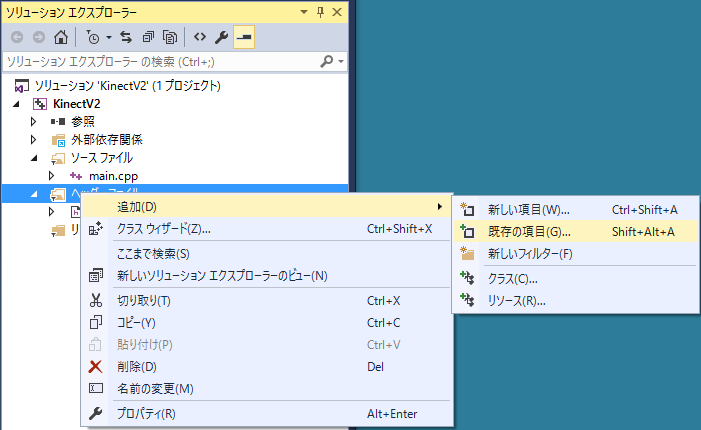Download a little modified WaveFile.h of "AudioCaptureRaw-Console C++ Sample" by Microsoft, and place it in the folder where other souce files (such as main.cpp) are located. Then, add it to the project.


Define USE_AUDIO constant before including NtKinect.h.
Call the openAudioFile() function to start recording, and closeAudioFile() to end recording. Audio is acquired with setAudio() function, and audio is automatically saved in the file during recording.
In the example program below, we create a WAV file whose name is current time like "2016-07-18_09-16-32.wav".
| main.cpp |
#include <iostream> #include <sstream> #define USE_AUDIO #include "NtKinect.h" using namespace std; #include <time.h> string now() { char s[1024]; time_t t = time(NULL); struct tm lnow; localtime_s(&lnow, &t); sprintf_s(s, "%04d-%02d-%02d_%02d-%02d-%02d", lnow.tm_year + 1900, lnow.tm_mon + 1, lnow.tm_mday, lnow.tm_hour, lnow.tm_min, lnow.tm_sec); return string(s); } void doJob() { NtKinect kinect; bool flag = false; while (1) { kinect.setRGB(); if (flag) kinect.setAudio(); cv::putText(kinect.rgbImage, flag ? "Recording" : "Stopped", cv::Point(50, 50), cv::FONT_HERSHEY_SIMPLEX, 1.2, cv::Scalar(0, 0, 255), 1, CV_AA); // rename CV_AA as cv::LINE_AA (in case of opencv3 and later) cv::imshow("rgb", kinect.rgbImage); auto key = cv::waitKey(1); if (key == 'q') break; else if (key == 'r') flag = true; else if (key == 's') flag = false; if (flag && !kinect.isOpenedAudio()) kinect.openAudio(now() + ".wav"); else if (!flag && kinect.isOpenedAudio()) kinect.closeAudio(); } cv::destroyAllWindows(); } int main(int argc, char** argv) { try { doJob(); } catch (exception &ex) { cout << ex.what() << endl; string s; cin >> s; } return 0; } |
Recording starts with 'r' key, and stops with 's' key. Recording status is displayed as "Recording" or "Stopped" at the upper left of the RGB image.
Since the above zip file may not include the latest "NtKinect.h", Download the latest version from here and replace old one with it.